Two Contributions to Rolling Contact Fatigue Testing Considering Different Diameters of Rail and Wheel Discs
Abstract
:1. Introduction
Material and Background
2. Specimen Geometry Optimization for High Contact Pressures
2.1. Numerical Modeling
2.1.1. Constitutive Model
2.1.2. Finite Element Simulations
2.1.3. Results of FE Simulations
2.2. Experimental Verification
2.2.1. Experimental Setup
2.2.2. Results of Validation Experiments and Discussion
3. Real-Time Contact Contour Measurement
3.1. Experimental Setup
3.2. Testing Conditions
3.3. Test Results and Discussion
4. Discussion
5. Conclusions
- The FE simulations using the Chaboche cyclic plasticity model proved to be an effective tool for the geometric optimization of the discs, especially in cases where the wheel disc and the rail disc have different diameters and also if higher levels of contact pressure are applied.
- The wear-evaluation approach based on the use of laser profilers is a slightly more complex setup. However, the results obtained clearly indicate its full applicability in the given field.
- The experimental setup will also be used in the field of loading-force regulation, which will ensure more stable simulated conditions, such as actual contact pressure or slip due to the monitoring of disc-dimensional parameters.
Author Contributions
Funding
Data Availability Statement
Acknowledgments
Conflicts of Interest
References
- Hannemann, R.; Köster, P.; Sander, M. Fatigue crack growth in wheelset axles under bending and torsional loading. Int. J. Fatigue 2019, 118, 262–270. [Google Scholar] [CrossRef]
- Ma, W.; Song, R.; Liu, W.; Luo, S. The influence of journal box position error on wheelset asymmetric flange wear of the 2C0-type locomotive. Wear 2014, 314, 314–320. [Google Scholar] [CrossRef]
- Bracciali, A.; Megna, G. Contact mechanics issues of a vehicle equipped with partially independently rotating wheelsets. Wear 2016, 366–367, 233–240. [Google Scholar] [CrossRef]
- Wang, W.J.; Lewis, S.R.; Lewis, R.; Beagles, A.; He, C.G.; Liu, Q.Y. The role of slip ratio in rolling contact fatigue of rail materials under wet conditions. Wear 2016, 376–377, 1892–1900. [Google Scholar] [CrossRef]
- Fletcher, D.I.; Beynon, J.H. Development of a machine for closely controlled rolling contact fatigue and wear testing. J. Test. Eval. 2000, 28, 267–275. [Google Scholar]
- Halama, R.; Šofer, M.; Rojíček, J.; Fojtík, F.; Kolařík, K. A method for predicting ratcheting and wear in rolling contact fatigue, taking technological residual stresses into consideration. Teh. Vjesn. 2017, 24, 7–14. [Google Scholar]
- Santa, J.F.; Cuervo, P.; Christoforou, P.; Harmon, M.; Beagles, A.; Toro, A.; Lewis, R. Twin disc assessment of wear regime transitions and rolling contact fatigue in R400HT—E8 pairs. Wear 2019, 432–433, 102916. [Google Scholar] [CrossRef]
- Hannemann, R.; Köster, P.; Sander, M. Investigations on crack propagation in wheelset axles under rotating bending and mixed mode loading. Procedia Struct. Integr. 2017, 5, 861–868. [Google Scholar] [CrossRef]
- Lewis, S.R.; Lewis, R.; Cotter, J.; Lu, X.; Eadie, D.T. A new method for the assessment of traction enhancers and the generation of organic layers in a twin-disc machine. Wear 2016, 366–367, 258–267. [Google Scholar] [CrossRef]
- HyunWook, L. Generation of airborne wear particles from the wheel–rail contact under wet conditions using a twin-disk rig. Wear 2020, 448–449, 203236. [Google Scholar]
- Suhr, B.; Skipper, W.A.; Lewis, R.; Six, K. Sanded Wheel–Rail Contacts: Experiments on Sand Crushing Behaviour. Lubricants 2023, 11, 38. [Google Scholar] [CrossRef]
- Shrestha, S.; Spiryagin, M.; Bernal, E.; Wu, Q.; Cole, C. Recent advances in wheel-rail RCF and wear testing. Friction 2023, 11, 2181–2203. [Google Scholar] [CrossRef]
- Ramalho, A.; Esteves, M.; Marta, P. Friction and wear behavior of rolling-sliding steel contacts. Wear 2013, 302, 1468–1480. [Google Scholar] [CrossRef]
- Andersson, P.; Hemming, B. Determination of wear volumes by chromatic confocal measurements during twin-disc tests with cast iron and steel. Wear 2015, 338–339, 95–104. [Google Scholar] [CrossRef]
- Nagato, K.; Shintani, K.; Hamaguchi, T.; Nakao, M. Real-time detection of microcracks with floating giant-magnetoresistance sensor in twin-disk sliding tests. CIRP Ann. 2017, 66, 539–542. [Google Scholar] [CrossRef]
- Zhu, J.; Withers, P.; Wu, J.; Liu, F.; Yi, Q.; Tian, G. Characterization of Rolling Contact Fatigue Cracks in Rails by Eddy Current Pulsed Thermography. IEEE Trans. Ind. Inform. 2020, 17, 2307–2315. [Google Scholar] [CrossRef]
- Lin, Q.; Jiang, S.; Tian, H.; Ding, H.; Wang, W.; Guo, J.; Liu, Q. Study on non-destructive testing of rail rolling contact fatigue crack based on magnetic barkhausen noise. Wear 2023, 528–529, 204965. [Google Scholar] [CrossRef]
- Schmidová, E.; Neslušan, M.; Ondruš, J.; Trojan, K.; Pitoňák, M.; Klejch, F.; Ramesha, S.K. Monitoring of Plastic Straining Degree of Components Made of Interstitial Free Steel after Uniaxial Tensile Test by the Use of Barkhausen Noise Technique. Steel Res. Int. 2021, 93, 2100597. [Google Scholar] [CrossRef]
- Provezza, L.; Bodini, I.; Petrogalli, C.; Lancini, M.; Solazzi, L.; Faccoli, M. Monitoring the Damage Evolution in Rolling Contact Fatigue Tests Using Machine Learning and Vibrations. Metals 2021, 11, 283. [Google Scholar] [CrossRef]
- Halama, R.; Fajkoš, R.; Matušek, P.; Bábková, P.; Fojtík, F.; Václavek, L. Contact defects initiation in railroad wheels—Experience, experiments and modelling. Wear 2011, 271, 174–185. [Google Scholar] [CrossRef]
- Kapoor, A. A Re-evaluation of the Life to Rupture of Ductile Metals by Cyclic Plastic Strain. Fatigue Fract. Eng. Mater. Struct. 1994, 17, 201–219. [Google Scholar] [CrossRef]
- McDowell, D.L. Stress state dependence of cyclic ratchetting behavior of two rail steels. Int. J. Plast. 1995, 11, 397–421. [Google Scholar] [CrossRef]
- Zhang, S.; Liu, Q.; Spiryagin, M.; Wu, Q.; Ding, H.; Wen, Z.; Wang, W. Gaps, challenges and possible solution for prediction of wheel–rail rolling contact fatigue crack initiation. Rail. Eng. Sci. 2023, 31, 207–232. [Google Scholar] [CrossRef]
- Hwang, J.-I.; Coors, T.; Pape, F.; Poll, G. Simulation of a Steel-Aluminum Composite Material Subjected to Rolling Contact Fatigue. Lubricants 2019, 7, 109. [Google Scholar] [CrossRef]
- Ringsberg, J.W. Life Prediction of Rolling Contact Fatigue Crack Initiation. Int. J. Fatigue 2001, 23, 575–586. [Google Scholar] [CrossRef]
- Halama, R.; Fusek, M.; Šofer, M.; Poruba, Z.; Matušek, P.; Fajkoš, R. Ratcheting Behavior of Class C Wheel Steel and Its Prediction by Modified AbdelKarim-Ohno Model. In Proceedings of the International Conference on Contact Mechanics of Wheel/Rail Systems, CM2015, Colorado Springs, CO, USA, 30 August–3 September 2015. [Google Scholar]
- Deng, T.S.; Zhao, X.; Wu, B.; Li, W.; Wen, Z.F.; Jin, X.S. Prediction of Crack Initiation of Rail Rolling Contact Fatigue. Appl. Mech. Mater. 2013, 344, 75–82. [Google Scholar] [CrossRef]
- Jiang, Y. A fatigue criterion for general multiaxial loading. Fatigue Fract. Eng. Mater. Struct. 2000, 23, 19–32. [Google Scholar] [CrossRef]
- Rodríguez-Arana, B.; San Emeterio, A.; Alvarado, U.; Martínez-Esnaola, J.M.; Nieto, J. Prediction of Rolling Contact Fatigue Behavior in Rails Using Crack Initiation and Growth Models along with Multibody Simulations. Appl. Sci. 2021, 11, 1026. [Google Scholar] [CrossRef]
- Halama, R.; Šmach, J.; Matušek, P.; Sakaino, T. Ratcheting prediction based development of rolling contact fatigue test for high pressures. In Proceedings of the 11th International Conference on Contact Mechanics and Wear of Rail/wheel Systems, CM 2018, Delft, The Netherlands, 24–27 September 2018; pp. 350–355. [Google Scholar]
- Klimenda, F.; Skocilas, J.; Skocilasova, B.; Soukup, J.; Cizek, R. Vertical Oscillation of Railway Vehicle Chassis with Asymmetry Effect Consideration. Sensors 2022, 22, 4033. [Google Scholar] [CrossRef]
- Jakubovičová, L.; Sága, M.; Vaško, M. Impact analysis of mutual rotation of roller bearing rings on the process of contact stresses in rolling elements. Manuf. Technol. 2013, 13, 50–54. [Google Scholar] [CrossRef]
- Pletz, M.; Meyer, K.A.; Künstner, D.; Scheriau, S.; Daves, W. Cyclic plastic deformation of rails in rolling/sliding contact –quasistatic FE calculations using different plasticity models. Wear 2019, 436–437, 202992. [Google Scholar] [CrossRef]
- Meyer, K.A.; Skrypnyk, R.; Pletz, M. Efficient 3d finite element modeling of cyclic elasto-plastic rolling contact. Tribol. Int. 2021, 161, 10705. [Google Scholar] [CrossRef]
- Gschwandl, T.J.; Weniger, T.M.; Antretter, T.; Künstner, D.; Scheriau, S.; Daves, W. Experimental and Numerical Visualisation of Subsurface Rail Deformation in a Full-Scale Wheel–Rail Test Rig. Metals 2023, 13, 1089. [Google Scholar] [CrossRef]
- Roshan, C.C.; Raghul, C.; Ram, H.V.; Suraj, K.; Solomon, J. Non-destructive testing by liquid penetrant testing and ultrasonic testing—A review. Int. J. Adv. Res. Ideas Innov. Technol. 2019, 5, 694–697. [Google Scholar]
- Šmach, J.; Halama, R.; Marek, M. Advanced testing in rolling contact fatigue for wheel material investigation. In Proceedings of the Applied Mechanics 2018, University of West Bohemia, Pilsen, Czech Republic, 9–11 April 2018; pp. 139–141. [Google Scholar]
- Šmach, J.; Marek, M.; Šofer, M.; Fusek, M. Measurement of Twin-Disc Wear Resistance Test by Laser Profilometer. In Proceedings of the Experimental Stress Analysis 2020: 58th International Scientific Conference, Ostrava, Czech Republic, 19–22 October 2020; pp. 505–509. [Google Scholar]
- AAR M-107/M-208; Standard: AAR Manual of Standards and Recommended Practices Wheels and Axles Wheels, Carbon Steel Specification M-107/M-208. AAR: Pueblo, CO, USA, 2011.
- Coelho, L.; Batista, A.C.; Nobre, J.P.; Marques, M.J. Rolling and Rolling-Sliding Contact Fatigue Failure Mechanisms in 32 CrMoV 13 Nitrided Steel—An Experimental Study. Appl. Sci. 2021, 11, 10499. [Google Scholar] [CrossRef]
- Liu, J.P.; Li, Y.Q.; Zhou, Q.Y.; Zhang, Y.H.; Hu, Y.; Shi, L.B.; Wang, W.J.; Liu, F.S.; Zhou, S.B.; Tian, C.H. New insight into the dry rolling-sliding wear mechanism of carbide-free bainitic and pearlitic steel. Wear 2019, 432–433, 202943. [Google Scholar] [CrossRef]
- Diener, M.; Ghidini, A. Fracture Toughness: A Quality Index for Railway Solid Wheels. Mater. Perform. Charact. ASTM 2014, 3, 286–304. [Google Scholar] [CrossRef]
- Halama, R.; Markopoulos, A.; Šmach, J.; Govindaraj, B. Theory, Application and Implementation of Modified Abdel-Karim-Ohno model for Uniaxial and Multiaxial Fatigue Loading. In Fatigue Damage in Metals—Numerical Based Approaches and Applications; Elsevier: Amsterdam, The Netherlands, 2022; (in press). [Google Scholar]
- Johnson, K.L. Contact Mechanics; Cambridge University Press: Cambridge, UK, 1985. [Google Scholar]
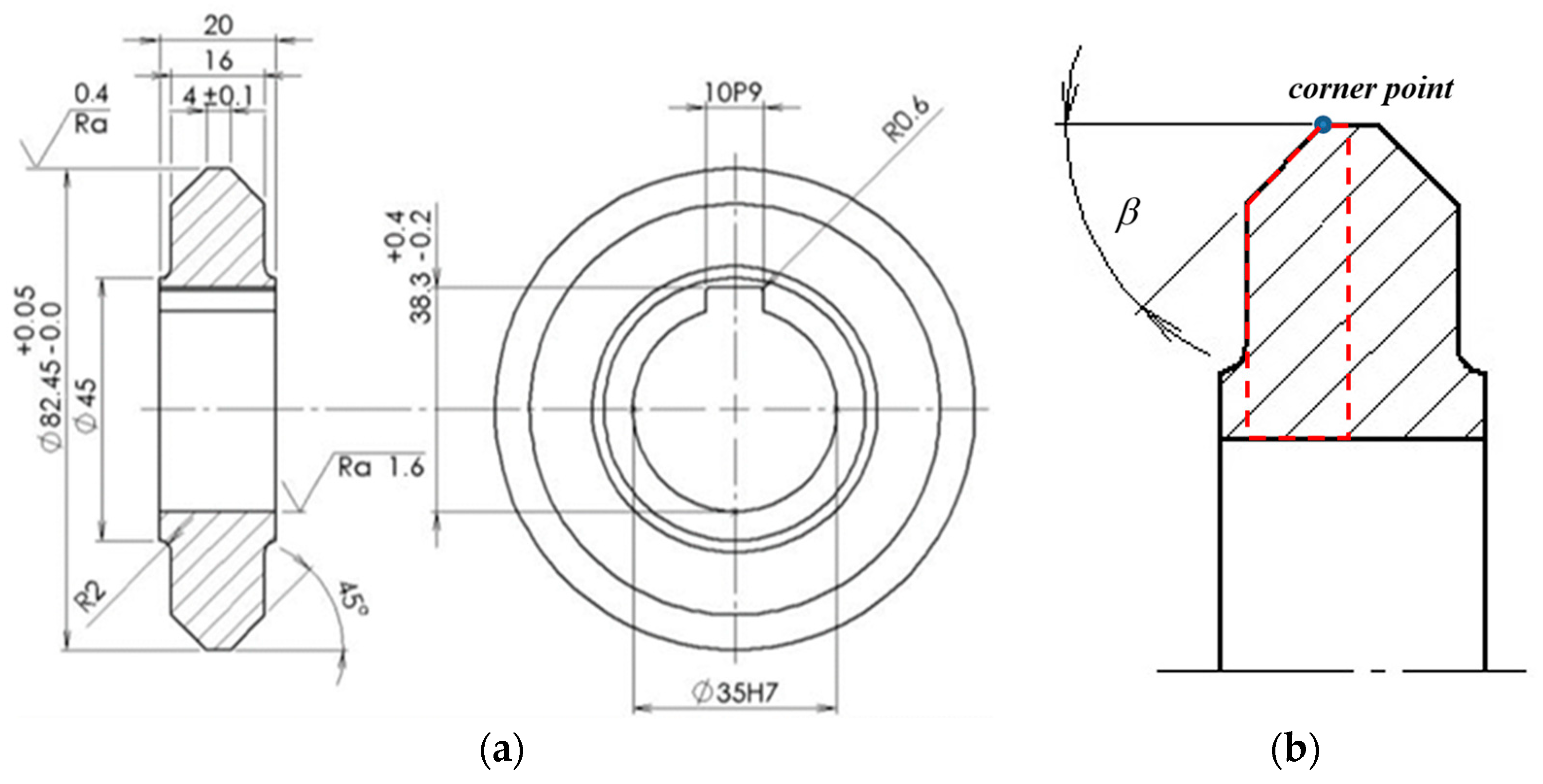
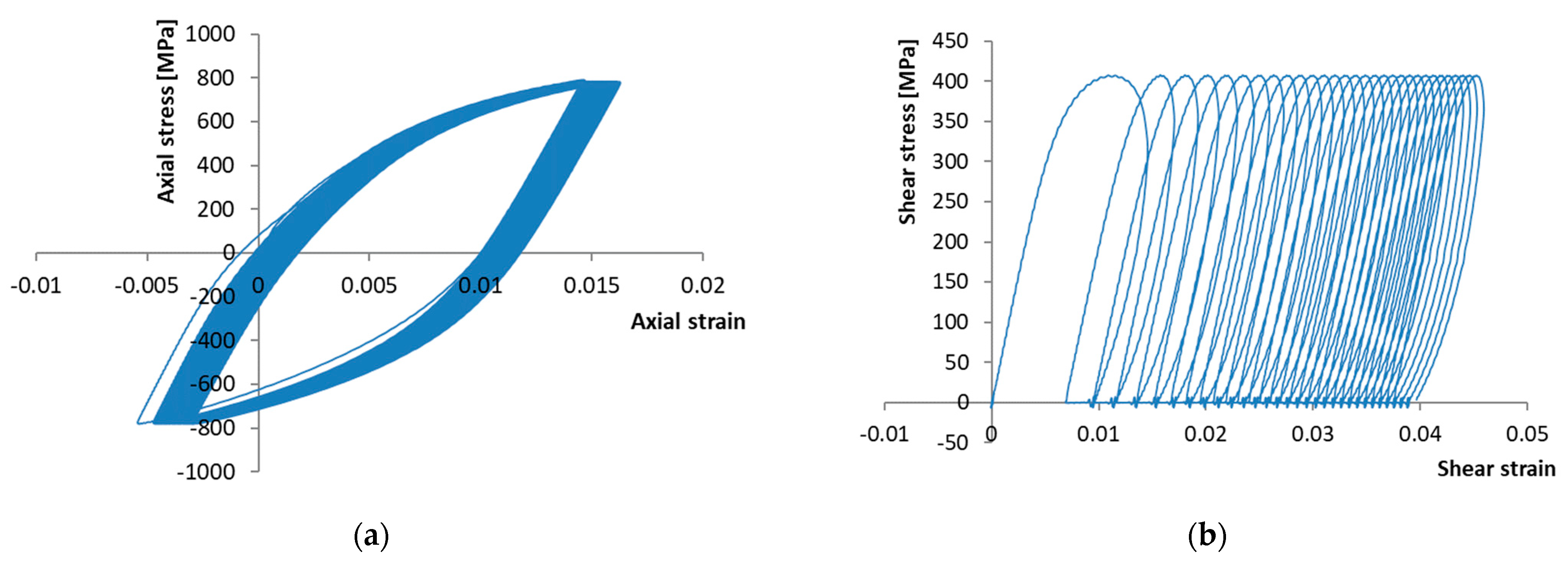
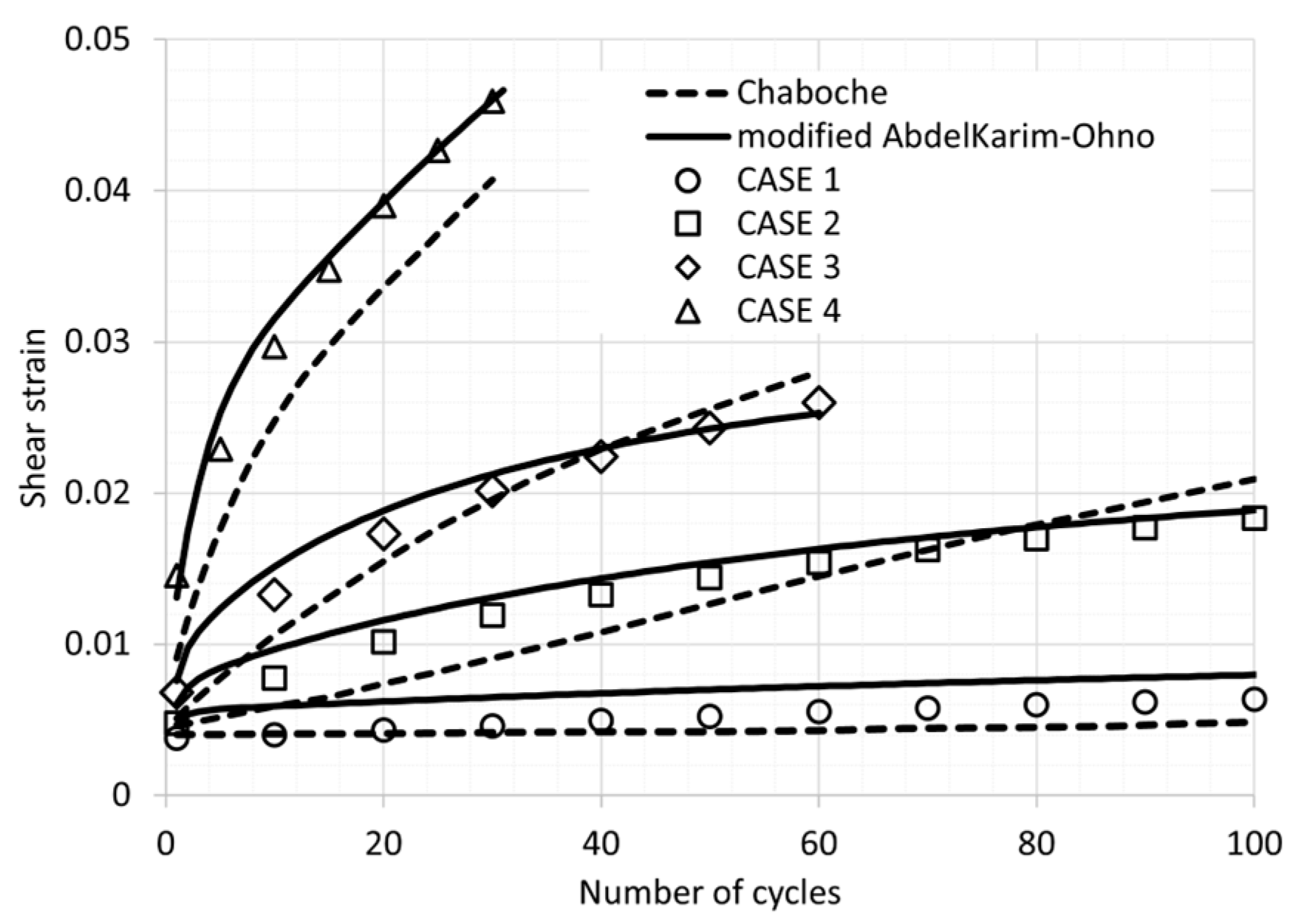

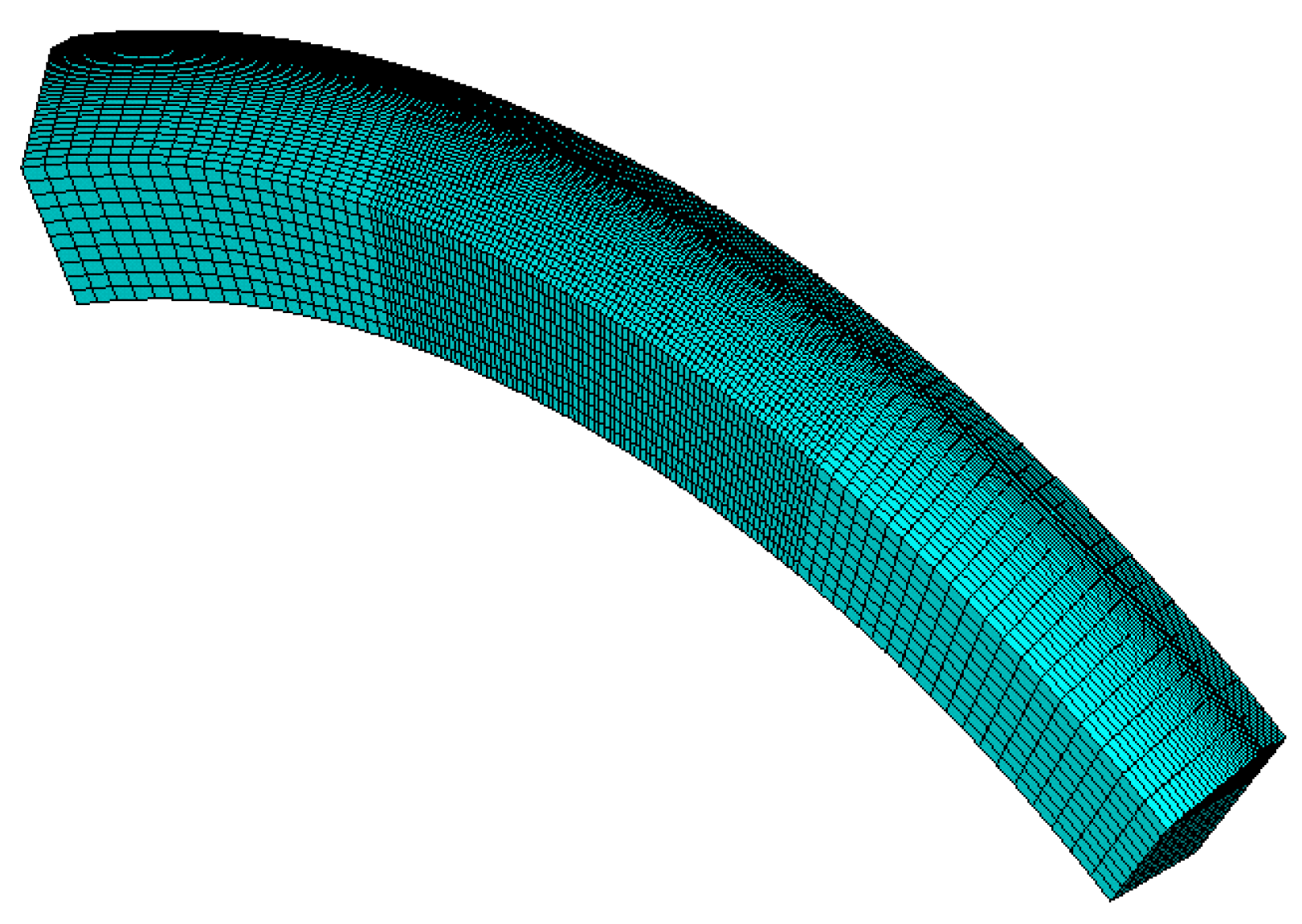
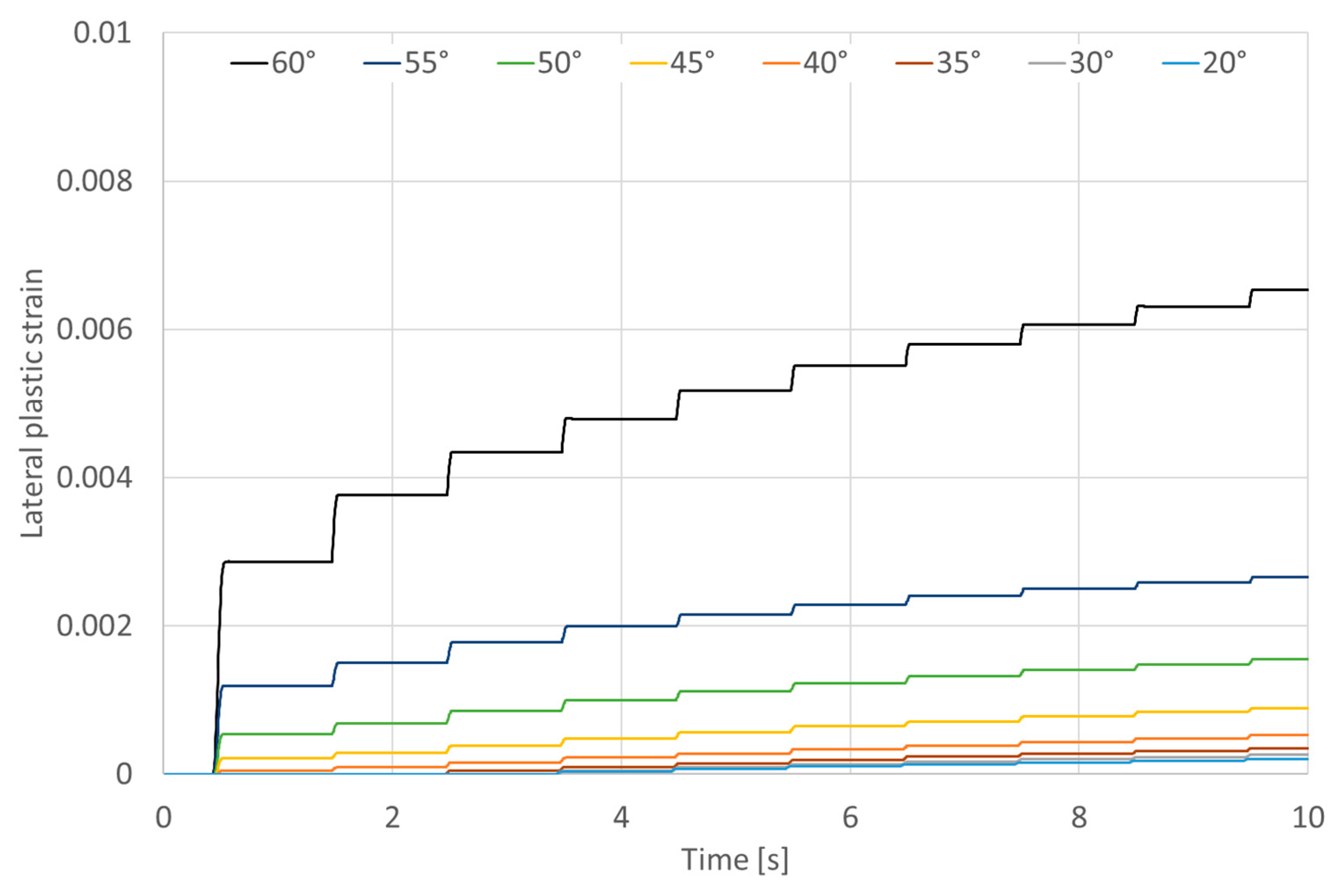
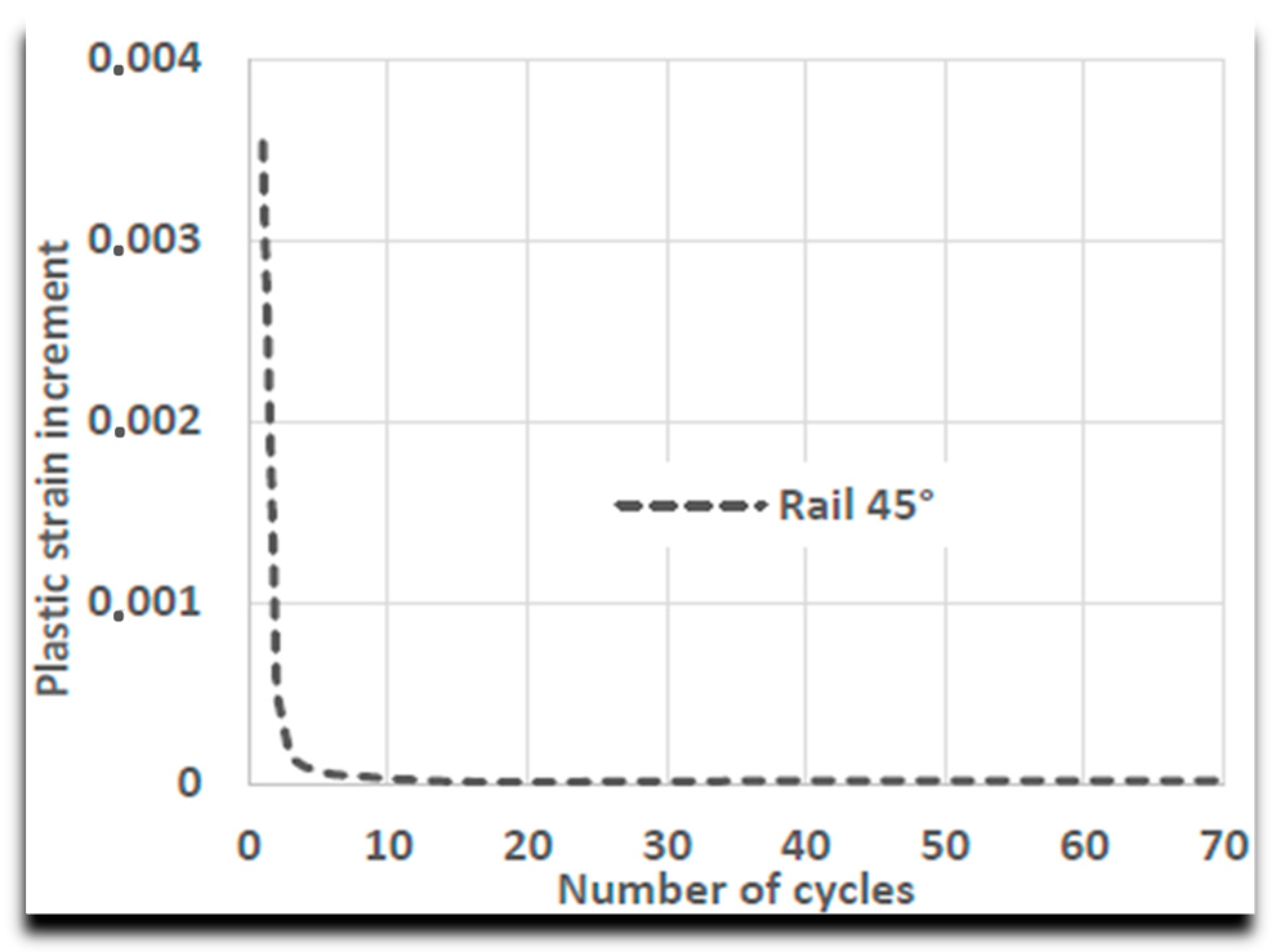
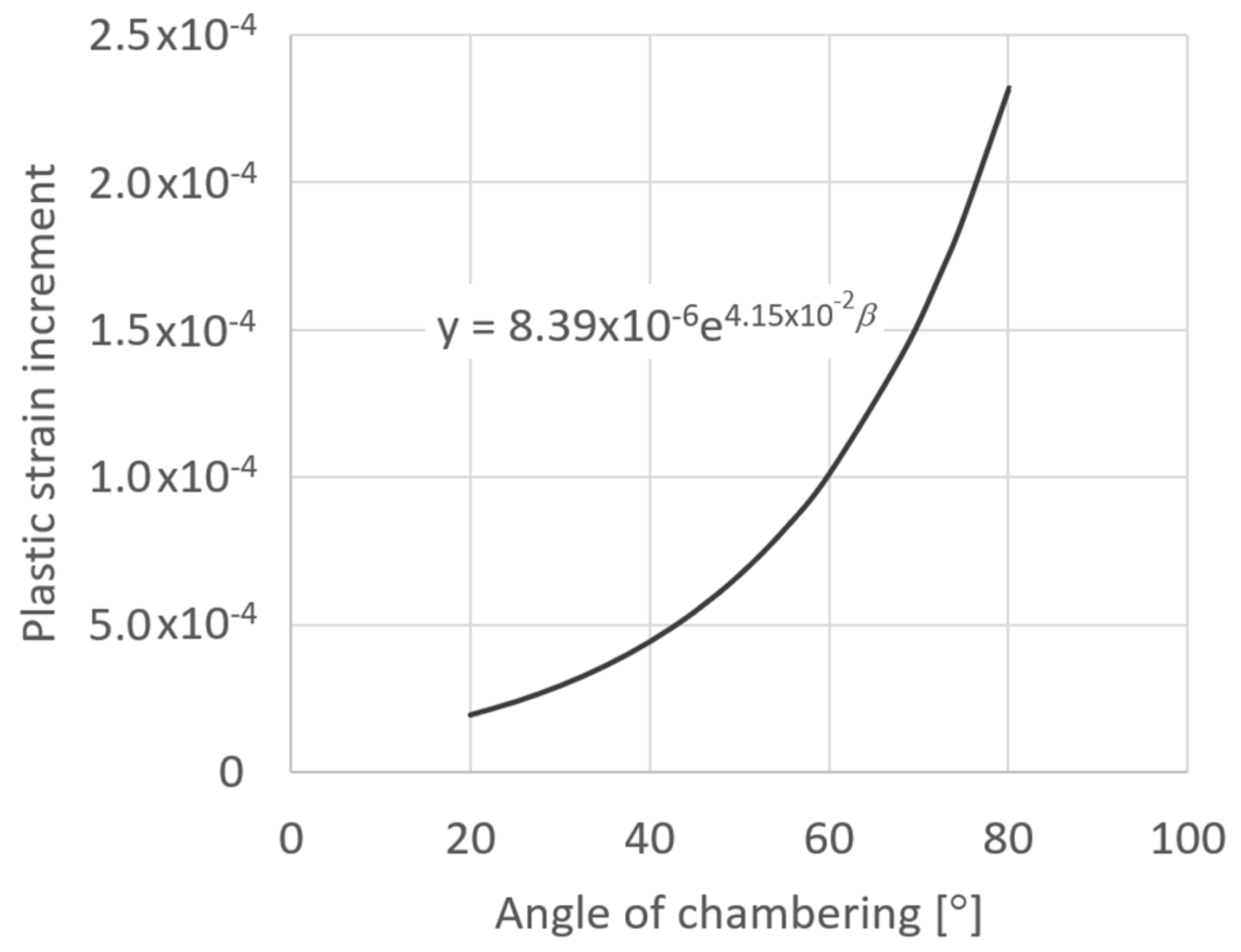

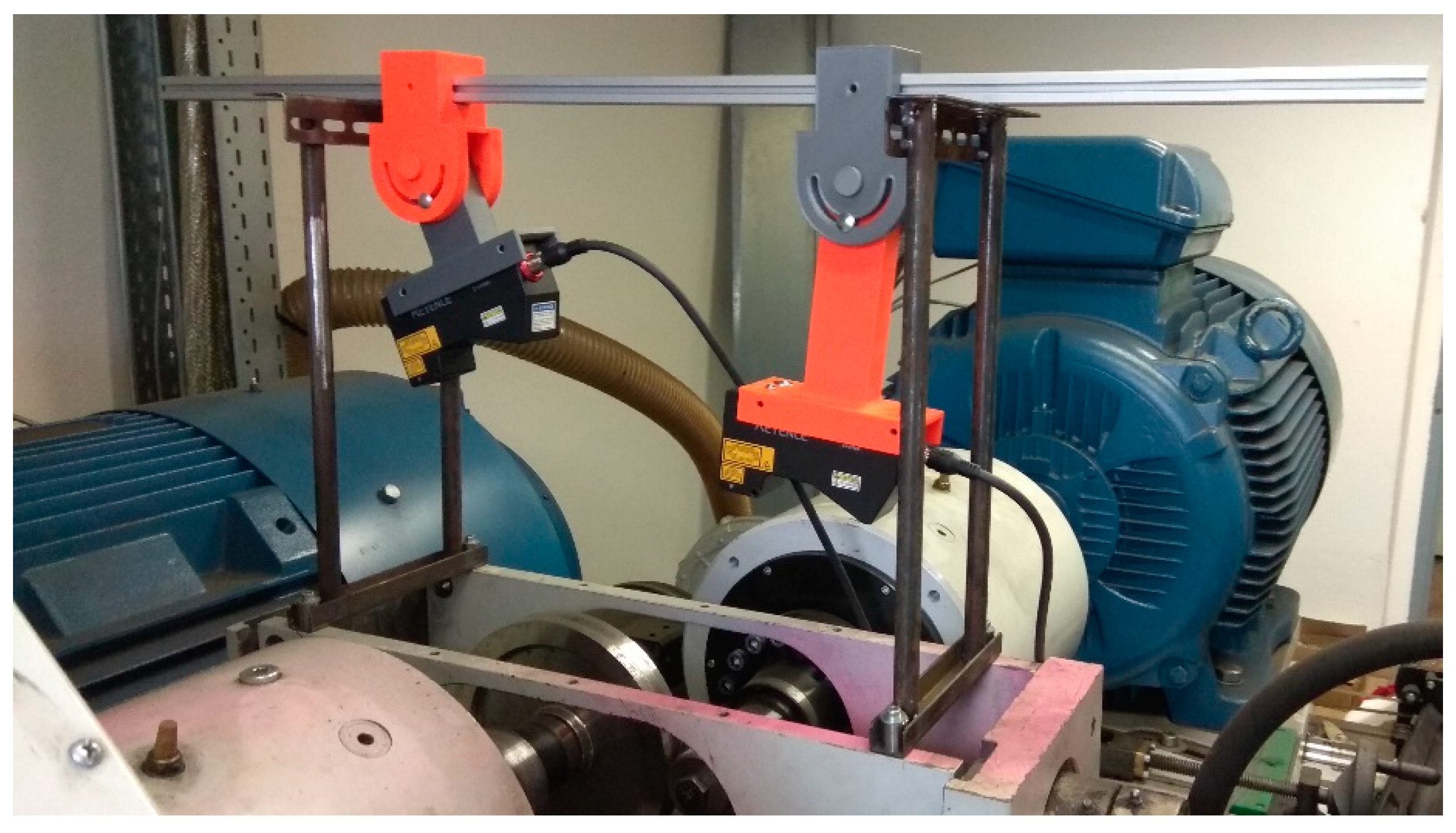


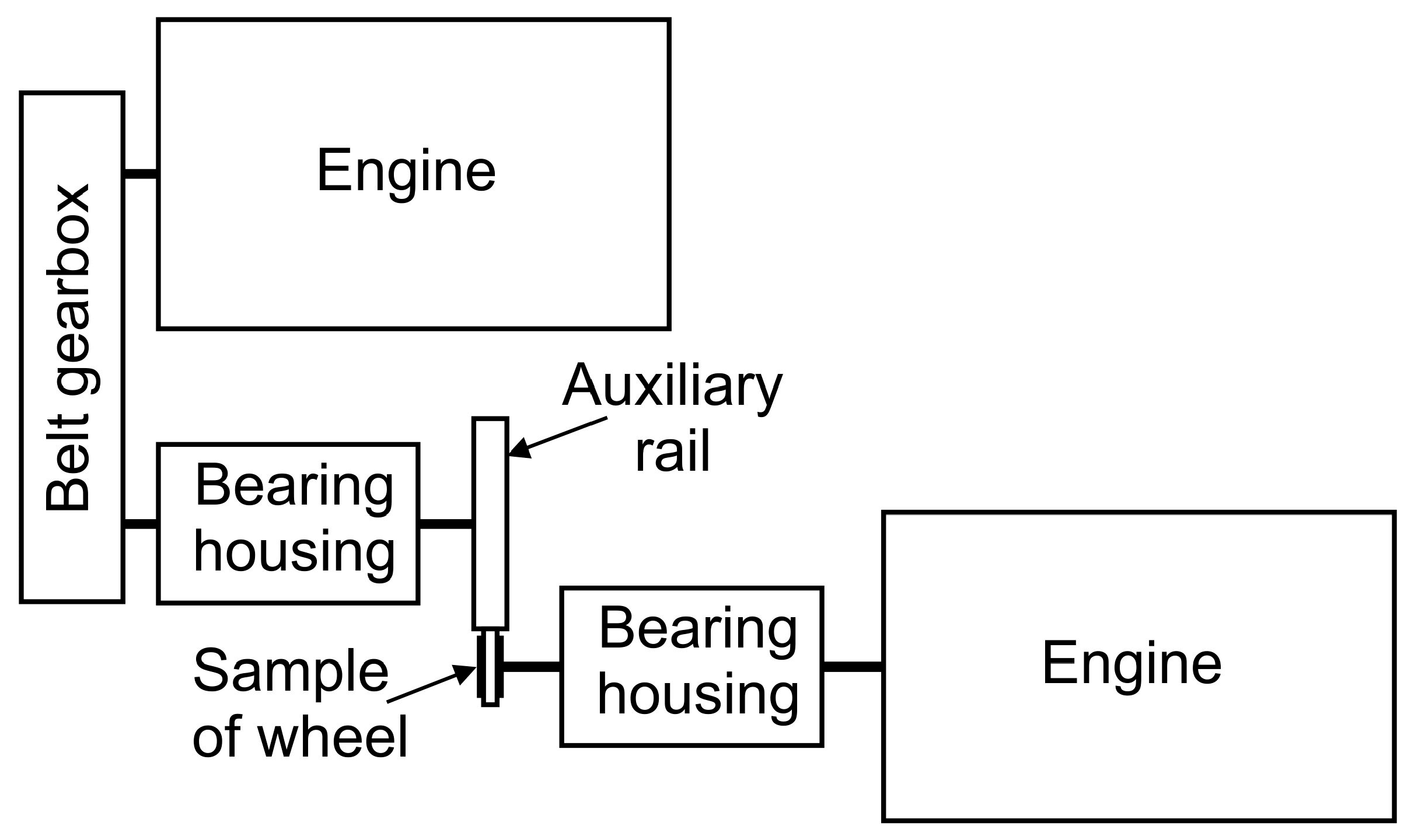
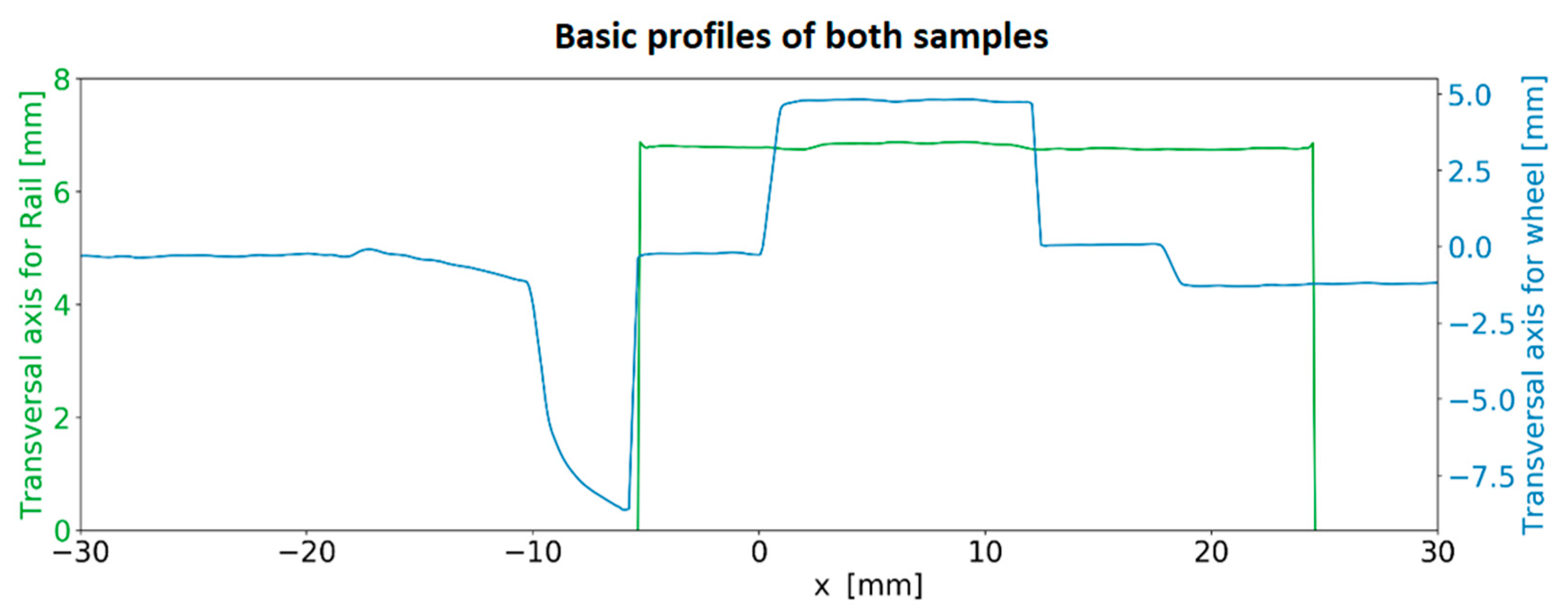
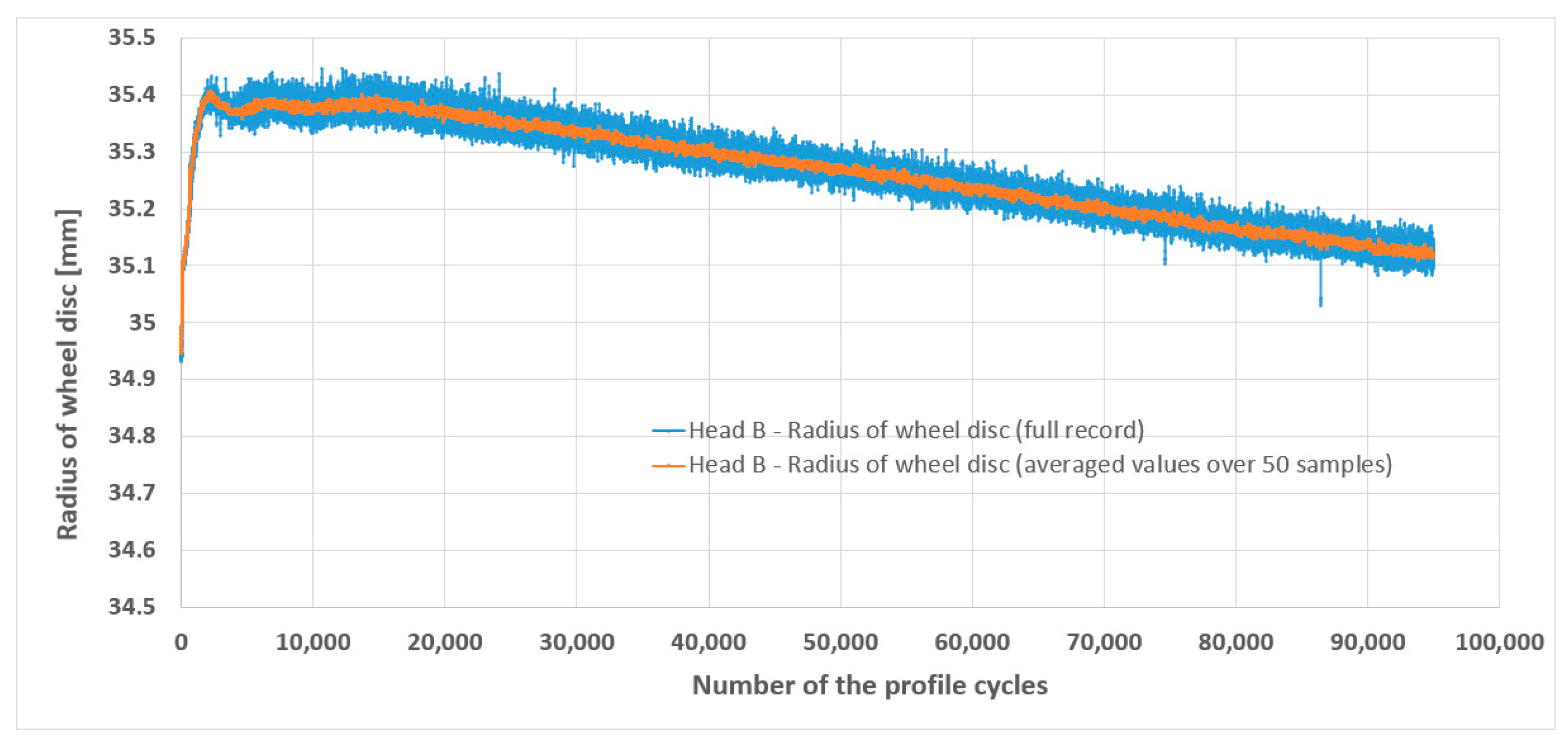





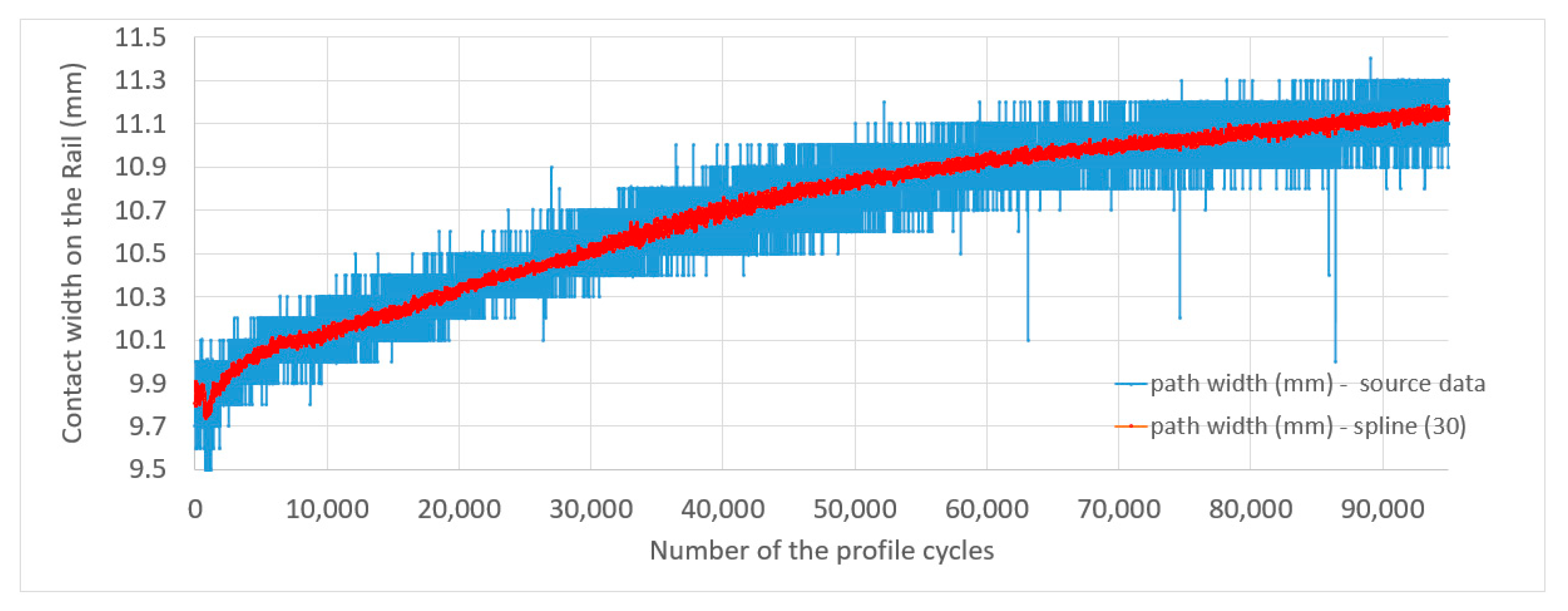
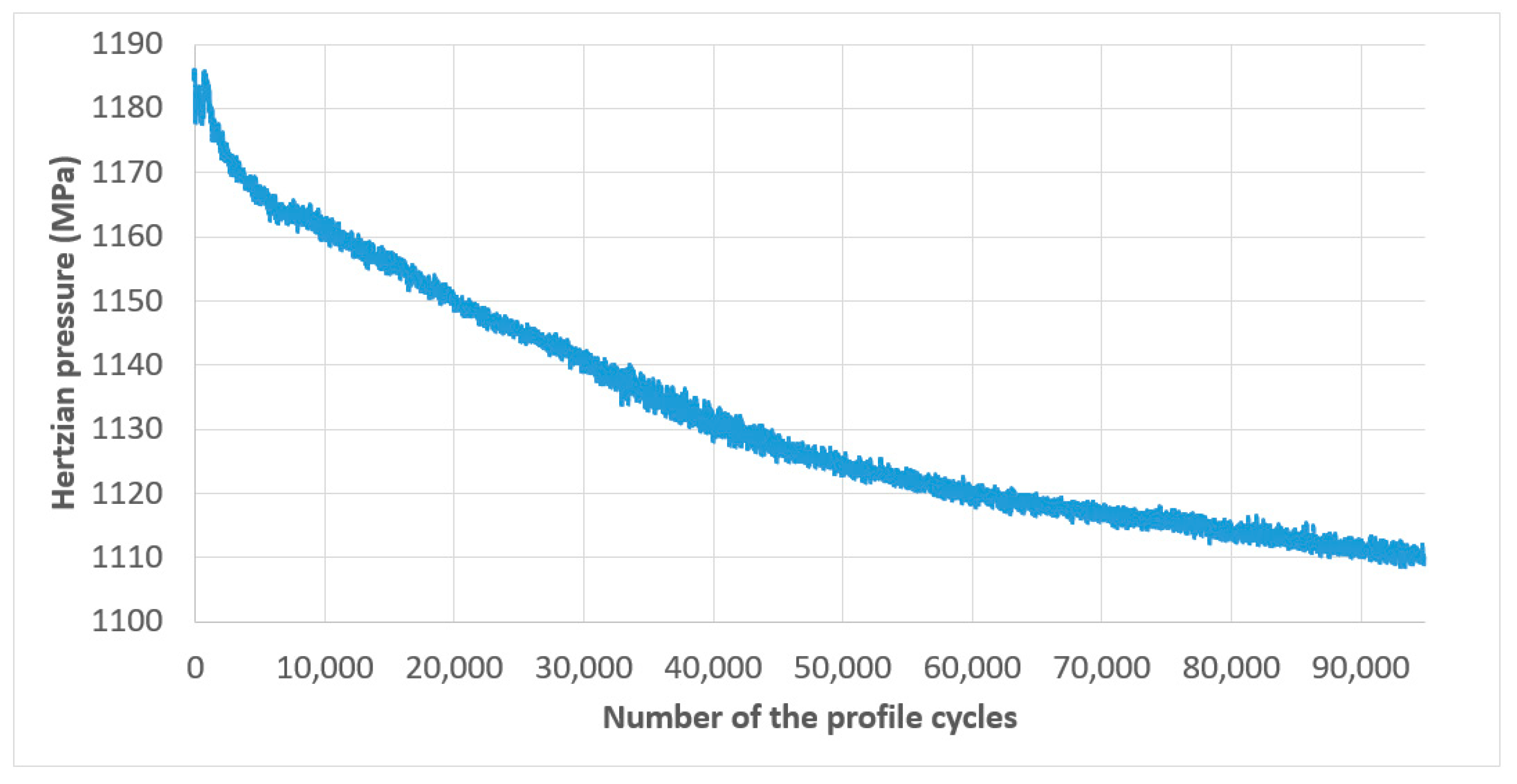
| Young Modulus [GPa] | Yield Strength [MPa] | Ultimate Strength [MPa] | Ductility [%] |
|---|---|---|---|
| 205 | 802 | 1270 | 13 |
| Parameter | Value |
|---|---|
| [MPa] | 550 |
| [MPa] | −100 |
| 10 | |
| [MPa] | 190,230, 86,250, 22,463, 7478, 13,810 |
| 2222, 690, 215, 103, 2.1 |
| Geometry | = 90° | = 70° |
|---|---|---|
| Surface roughness at the end of test Ra (µm): | ||
| Wheel | 0.63 | 0.67 |
| Rail | 0.33 | 0.67 |
| Total disc weight loss (g): | ||
| Wheel | 0.84 | 3.28 |
| Rail | 0.35 | 3.11 |
| Disc diameter loss (mm): | ||
| Wheel | 0.855 | 1.117 |
| Rail | 0.74 | 1.34 |
| Change of track width (mm): | ||
| Wheel | 3.93 | 3.36 |
| Rail | 2.6 | 3.2 |
| Number of cycles (wheel) | 100,000 | 215,000 |
| Max. coefficient of traction | 0.305 | 0.299 |
Disclaimer/Publisher’s Note: The statements, opinions and data contained in all publications are solely those of the individual author(s) and contributor(s) and not of MDPI and/or the editor(s). MDPI and/or the editor(s) disclaim responsibility for any injury to people or property resulting from any ideas, methods, instructions or products referred to in the content. |
© 2023 by the authors. Licensee MDPI, Basel, Switzerland. This article is an open access article distributed under the terms and conditions of the Creative Commons Attribution (CC BY) license (https://creativecommons.org/licenses/by/4.0/).
Share and Cite
Šmach, J.; Halama, R.; Marek, M.; Šofer, M.; Kovář, L.; Matušek, P. Two Contributions to Rolling Contact Fatigue Testing Considering Different Diameters of Rail and Wheel Discs. Lubricants 2023, 11, 504. https://doi.org/10.3390/lubricants11120504
Šmach J, Halama R, Marek M, Šofer M, Kovář L, Matušek P. Two Contributions to Rolling Contact Fatigue Testing Considering Different Diameters of Rail and Wheel Discs. Lubricants. 2023; 11(12):504. https://doi.org/10.3390/lubricants11120504
Chicago/Turabian StyleŠmach, Jiří, Radim Halama, Martin Marek, Michal Šofer, Libor Kovář, and Petr Matušek. 2023. "Two Contributions to Rolling Contact Fatigue Testing Considering Different Diameters of Rail and Wheel Discs" Lubricants 11, no. 12: 504. https://doi.org/10.3390/lubricants11120504
APA StyleŠmach, J., Halama, R., Marek, M., Šofer, M., Kovář, L., & Matušek, P. (2023). Two Contributions to Rolling Contact Fatigue Testing Considering Different Diameters of Rail and Wheel Discs. Lubricants, 11(12), 504. https://doi.org/10.3390/lubricants11120504






